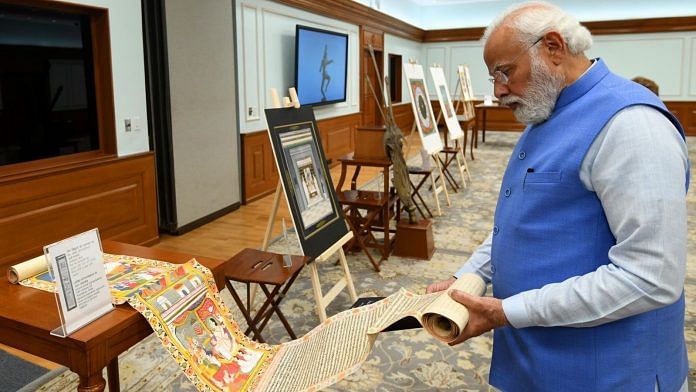New Delhi: As many as 29 antiquities, ranging from statues and sculptures of Lord Shiva and Lord Vishnu to 20th century portraits, were handed over to India by Australia Monday, ahead of Prime Minister Narendra Modi’s virtual meeting with his Australian counterpart Scott Morrison.
The retrieval came as part of India’s ongoing effort to get back stolen heritage sculptures and paintings from other nations, officials said.
PM Modi also inspected the antiquities, which belonged to different time periods — with the earliest dating to 9-10th century.
The artefacts have been divided into six broad categories — Shiva and his disciples, Worshipping Shakti, Lord Vishnu & his forms, Jain tradition, portraits and decorative objects. They were from regions across the country including Rajasthan, Gujarat, Madhya Pradesh, Uttar Pradesh, Tamil Nadu, Telangana and West Bengal.
Here is the complete list
Shiva and his disciples
-
Shiva Bhairava: A 9th-10th century sandstone sculpture from Rajasthan. Shiva Bhairava is considered a fierce manifestation of Shiva, associated with annihilation.
-
The child-saint Sambandar : A 12th century bronze statue from Tamil Nadu. The sculpture displays the saint’s childlike quality, while also empowering him with the maturity and authority of a spiritual leader.
-
The dancing child-saint Sambandar: A bronze statue from the 12th century. The child saint Sambandar, one of a group of sixty-three saints who adored Shiva, lived in the seventh century in the south Indian state of Tamil Nadu.
-
The Saint Chandikesvara: A 14th century sculpture where Chandikesvara is shown yielding an axe, standing with folded hands, on a lotus pedestal.
-
Shiva and Parvati: The piece was made sometime around 1830-40 in Kangra, Himachal Pradesh. The painting is opaque, watercolour heightened with gold on paper.
-
Dancing Sambandar: It is a 14th century sculpture from South India. Sambandar is depicted dancing on a lotus, with one leg raised, his right hand pointing towards the heavens, while his left is in gajahasta mudra.
-
Yaksha Bhairava: Another mid 19th century painting from Jaipur, Rajasthan, it uses gouache, gold, silver, ink and coloured foil on paper.
Worshipping Shakti
-
Durga Mahisasuramardini: A 12-13th century sandstone sculpture from Gujarat. Durga is seen holding the Mahisha demon by his hair, with her tongue out, and an aggressive expression throughout her face.
-
Kali Yantra: An early 19th century painting from Varanasi (Benares), Uttar Pradesh. It is opaque and makes use of watercolour on paper.
Lord Vishnu and his forms
-
Lakshmi Narayana: A 10th-11 century sandstone sculpture from either Rajasthan or Uttar Pradesh. This beautiful sculptural frieze displays the Divine couple, probably Lakshmi Narayana, as central deities.
-
Not titled: This ‘Manorath’ portrait of donor and priests before Shri Nathji, Nathdwara was made by an unknown artist in Rajasthan’s Udaipur. It is opaque, watercolor on paper.
-
Varaha rescuing the Earth Goddess: A painting from circa 1720-1730 Bikaner, Rajasthan. Opaque, watercolour heightened with gold on paper.
-
Baby Krishna on a banyan leaf: A painting from second half of 18th century from Rajasthan’s Kota, it’s opaque, watercolour heightened with gold on paper.
-
Shrinathji: is a 19th century chromolithograph from Nathdvara, Rajasthan.
-
Krishna and Arjuna: An early 19th century painting from the Mewar region, Rajasthan.
Jain Tradition
-
Arch of a Jain shrine: A 11th-12th century marble from Mount Abu region, Rajasthan. Two Jaina Tirthankara are seen standing on either sides of the panel, topped with two other Tirthankara in dhyāna mudra, seated within a shrine-niche structure.
-
Seated Jina sculpture: A marble sculpture from Mouth Abu region, Rajasthan. The presence of the symbol of the Jaina deity, elephant, makes it possible that this Jaina deity is Ajitanath, the second Tirthankar, of the present avasarpini (half time cycle) according to Jainism.
-
Vijnaptipatra: The picture scroll from 19th century CE from Rajasthan comprises art in opaque pigments, gold and silver, on paper, and is a letter of invitation to the Jaina monks.
Portraits
-
Maharaja Sir Kishen Pershad Yamin Lala Deen Dayal (Circa 1903): Lala Deen Dayal worked as official photographer to the Nizam of Hyderabad during later part of 19th century.
-
Hiralal | A Gandhi memorial portrait Shah, Shanti C (Circa 1941): The painting is memorial portrait of Hiralal A. Gandhi, datable to 1941.
-
Not titled [Portrait of a man] (Circa 1954): The portrait painting of a middle-aged male is from the Venus Studio.
-
Not titled Gujarati family group portrait: The portrait of a Gujarati family group is a gelatin silver photo, from the Guru Das Studio. Shastiji Amritrai Karunashankar is mentioned at the bottom in Gujarati language.
-
Unknown portraiture [Portrait of a woman] from Udaipur, Rajasthan gelatin silver photograph.
-
Portrait of a gentleman by artist Panna Lal (Circa 1875) from Nathdwara, Rajasthan.
Decorative items
-
Page from a Ragamala series (Circa 1720) from Malwa region, Madhya Pradesh.
-
Young lady with elaborate saree (circa 1775) from Bundi, Rajasthan.
-
Processional standard (Alam) from 19th century CE Hyderabad, Telangana. This piece of art object may be identified with a processional standard that must have been carried by a stand bearer in processions.
-
Shri Lakshman Chandji before Shri Dursham Ramji from early 19th century Thikana, Rajasthan.
-
Amorous couple (Circa 1875) from Kalighat in West Bengal. Opaque and metallic pigment on paper.
Also read: India, Australia interim trade deal not in sight even after PM Modi’s summit with Morrison



